Slovenian Economic Mirror
Related Files:
Slovenian Economic Mirror 2/2023
Short-term indicators of economic activity for Slovenia point to weak growth at the beginning of the year in the export-oriented part of the economy and in most services, except in retail trade, and to further strengthening in construction. After several months of contraction, trade in goods increased in February, but remained lower than a year ago. Manufacturing output was higher in the first two months than in the last quarter of last year. It remained broadly unchanged year-on-year. According to our assessment, output was higher in the two high-technology industries (the manufacture of ICT equipment and the pharmaceutical industry), which are less affected by the slowdown in external demand growth and the energy crisis. Output in other groups, especially in more energy-intensive industries, was lower year-on-year. Growth of trade in services, driven since spring last year mainly by the post-COVID-19 recovery in tourism, continued in January and remained high year-on-year. At the beginning of the year, household expenditure on food, non-food products and overnight stays in Slovenia decreased year-on-year, while it increased on cars and tourist services abroad. The economic sentiment improved in the first quarter as a whole compared to the fourth quarter of last year, but was still below the level of the same period in 2022. The number of persons in employment continued to rise at the beginning of the year. Given there are labour shortages in most sectors, the employment of foreigners has increasingly contributed to this increase, almost 80% in January. The number of unemployed also continued to fall, according to data up to March. In March, consumer prices remained unchanged from the previous month, while inflation increased year-on-year, as expected (to 10.5%). Much of the increase was due to the lower base from last year when the government significantly reduced electricity prices by abolishing certain levies and charges. In March, prices of food and non-alcoholic beverages continue to be the main contributor to inflation.
Related Files:
- International environment
- Economic developments
- Labour market
- Prices
- Financial markets
- Balance of payments
- Public finance
Euro area composite Purchasing Managers’ Index (PMI), March 2023
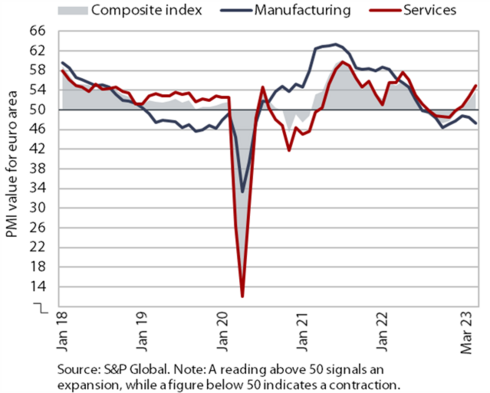
The available indicators for the euro area point to a modest growth of economic activity in the first quarter after stagnating in the last quarter of 2022. Amid high inflation, tighter financing conditions and high uncertainty, euro area GDP was unchanged in the fourth quarter of last year compared to the third quarter (1.8% year-on-year growth). Private consumption and investment declined significantly, while the contribution of net trade was positive. According to the available indicators, activity in the euro area slowly gathered momentum again in the first quarter. At the beginning of the year, industrial production and construction activity increased in current terms, while turnover in retail trade remained similar to that in the previous quarter. The composite PMI further rose in March, reaching its highest level in ten months. This was mainly due to activity in the services sector, while manufacturing output continued to be held back by weak demand. The Economic Sentiment Indicator (ESI) fell slightly in March, due to lower confidence in all activities and among consumers, but its quarterly average was higher than in the previous quarter. Economic sentiment in Slovenia’s largest trading partner Germany improved in March for the fifth month in a row. According to the German ifo Business Climate Index, companies were more optimistic about activities in the coming months and also about their current business situation.
IMF economic outlook, April 2023
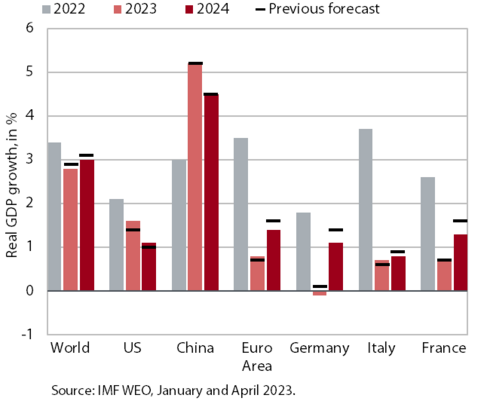
In April, the IMF slightly downgraded its growth forecasts for the global economy. The global economy continues to recover as China’s economy reopens, problems in supply chains and energy and food markets ease, and inflation gradually declines, but uncertainty has increased following the recent collapse of some banks and growing tensions in financial markets. According to the baseline scenario, which assumes that the financial turmoil in the banking sector is contained, global economic growth is expected to slow from 3.4% in 2022 to 2.8% in 2023 (0.1 p.p. lower than in the January forecast), followed by a slight increase in 2024 (to 3%). Growth in advanced economies in particular is expected to slow. Growth in the euro area is expected to fall from 3.5% last year to 0.8% this year, before picking up slightly next year (to 1.4%).
Commodity prices, March 2023
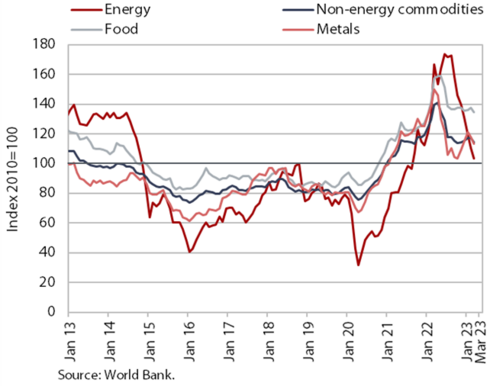
The average energy commodity prices on international markets fell significantly in the first quarter. Given that the storage capacities were relatively full for this time of the year (they were 55.6% full at the end of March), the euro prices of natural gas on the European market (Dutch TTF) further declined in March, by 17% month-on-month and by 77% year-on-year. The Brent Crude oil price was also significantly lower year-on-year in March, with a similar decline in dollar and euro prices (by around 30%). Compared to the previous month, the average prices per barrel fell by 5%, with the dollar price down to USD 78.4 and the euro price down to EUR 73.3. Oil prices fell as a result of weaker demand and growing uncertainty about future demand due to financial market tensions. According to the World Bank, the average dollar price of non-energy commodities fell by 2% in March compared to the previous month. Dollar prices of non-energy commodities were much lower year-on-year on average (by 18%), though still significantly higher than before the epidemic. On the international commodity markets, prices of all commodity groups were noticeably lower year-on-year, most notably those of fertilisers.
Effective exchange rates, February 2023
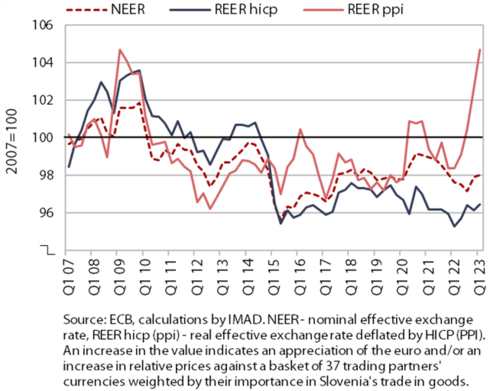
The price competitiveness of manufacturing deteriorated again in the first quarter of 2023. The exchange rate of the euro against the basket of currencies of Slovenia’s main trading partners (NEER) was relatively stable in the first months of this year. Competitiveness indicators (REER ppi and REER hicp) have thus deteriorated due to higher price growth in Slovenia compared to its trading partners. According to preliminary estimates, the gap was more pronounced especially in the growth of the producer price index (PPI), where relative prices had already started to rise in the course of last year. With a significant increase in the first quarter of this year, REER ppi matched the early 2009 peak.
Short-term indicators of economic activity in Slovenia, January–February 2023
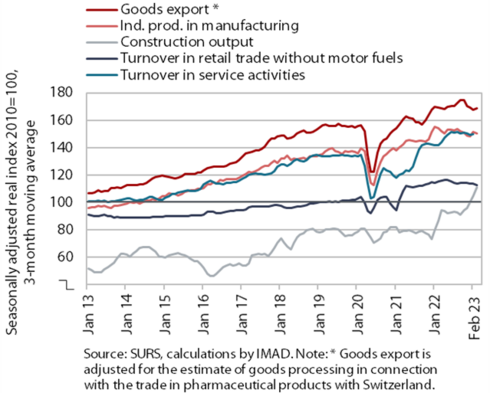
Short-term indicators of economic activity for Slovenia in the first two months point to weak growth in the export-oriented part of the economy and in most service sectors (with the exception of retail trade) but to further strengthening in construction. After several months of decline, trade in goods increased in February but was lower than a year ago. Manufacturing output increased on average in the first two months compared to the last quarter of last year, but it remained largely unchanged year-on-year. In most industries, especially the more energy-intensive ones, it was lower year-on-year, but it was higher in the two high-technology industries. Year-on-year growth in trade in services remained strong at the beginning of the year, mainly due to a significant recovery in trade in tourism-related services. Real income in services rose in January after falling in the previous months and was significantly higher year-on-year. However, real turnover in retail trade in January and February was lower on average than in the previous quarter and also year-on-year. Construction activity further increased in February. Compared to previous years, construction of residential buildings stood out in terms of activity. The economic climate improved in the first quarter compared to the last quarter of last year but deteriorated compared to the same period of 2022.
Electricity consumption, March 2023
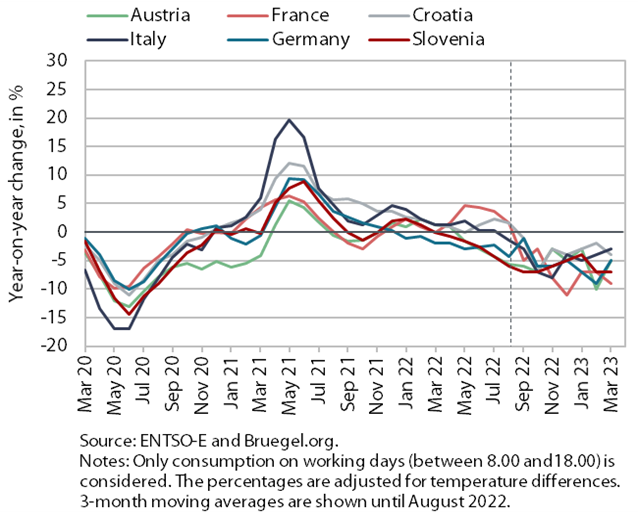
In March, electricity consumption was 7% lower year-on-year – the same decrease as in February. We assess that this was mainly due to lower industrial consumption. This is related both to a reduction in production activity, especially in some energy-intensive companies as a result of high energy prices, and to more efficient energy consumption. Household consumption also contributed to lower year-on-year consumption due to more rational use of energy and also because fewer people stayed at home than in the same period last year, when the number of COVID-19 infections increased and containment measures were in place. Slovenia’s main trading partners also recorded a year-on-year decline in consumption in March (France by 9%, Austria and Germany by 5%, Croatia by 4%, and Italy by 3%).
Electricity consumption by consumption group, March 2023
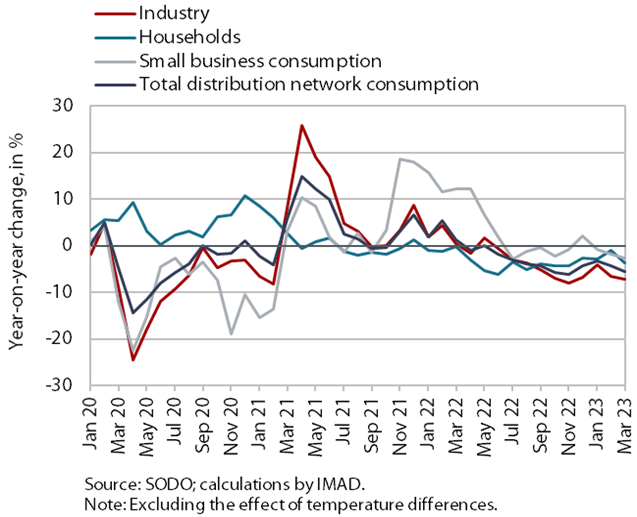
In March, electricity consumption in the distribution network was lower year-on-year in all consumption groups. As in previous months, industrial consumption declined the most (by 7.2%), which we assess to be mainly due to the energy-intensive part of the economy adjusting to high energy prices by increasing energy efficiency and reducing production. Household consumption was also lower in March than a year earlier (by 3.6%). We assess that this was due to a more rational energy consumption and the impact of COVID-19 measures (remote work, isolations and absences due to illness) on the higher base of last year. Small business consumption was 2.6% lower year-on-year in March.
Natural gas consumption, March 2023
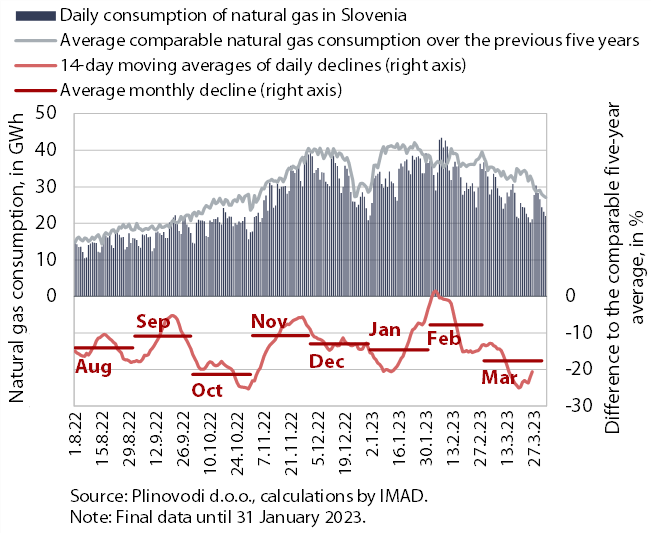
Gas consumption in March and in the period between August last year and March this year was 18% and 14% lower respectively than the average consumption in the same periods during the five preceding years. Lower gas consumption was due to lower production in some industries as a result of high gas prices and government measures to encourage more rational consumption, while mild weather also widened the gap with average gas consumption in March compared to February. In the last eight months, the decline in gas consumption in Slovenia compared to the same periods during the five preceding years was slightly below the EU recommendation to reduce gas consumption by at least 15%, whereas the EU as a whole reduced gas consumption by a fifth between August last year and January this year.
Value of fiscally verified invoices – nominal, March 2023
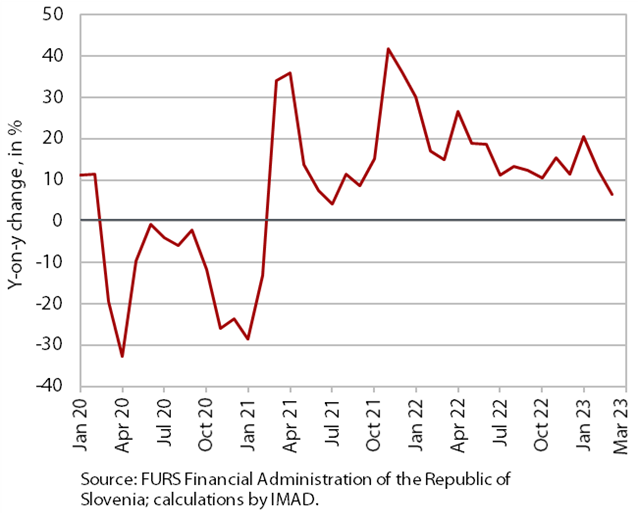
Year-on-year nominal growth in the value of fiscally verified invoices almost halved in March, given the high base of last year. It slowed to 7% due to last year’s high base, which was related to the lifting of containment measures and also to the outbreak of war in Ukraine. Year-on-year turnover growth more than halved in accommodation and food services (from 26% in February to 13% in March), certain creative, arts, entertainment and sports activities, and gambling and betting activities (total growth in other service activities was 15%). Year-on-year growth also slowed significantly (from 11% to 6%) in trade, which accounted for almost 80% of the total value of fiscally verified invoices issued. Turnover increased by 5% in nominal terms in retail trade and by 22% in the sale of motor vehicles. Turnover in wholesale trade was similar to March last year.
Trade in goods – in real terms, February 2023
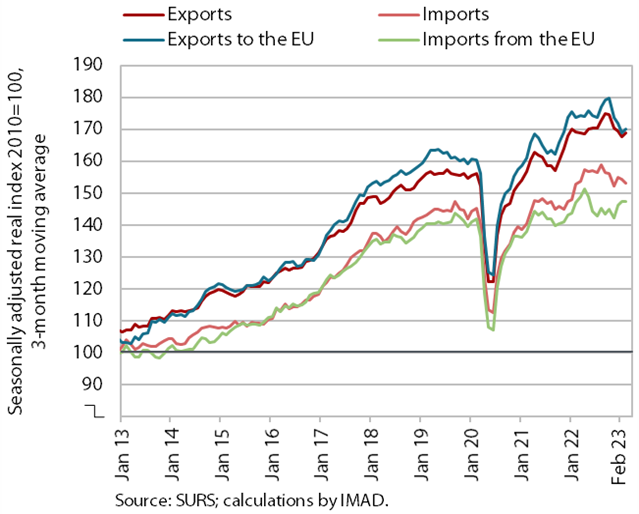
After several months of decline, trade in goods increased in February but remained lower than a year ago. After months of decline, real exports rose by 1.5% in February (by 4.5% to EU Member States, seasonally adjusted), while imports fell by 3.9% (by 5.3% from EU Member States, seasonally adjusted). On the export side, the development in recent months was mainly influenced by weak activity in Slovenia’s main trading partners within the EU, especially the decline in exports of intermediate goods (mainly metals and metal products). On the import side, the large monthly fluctuations in imports of intermediate goods point to uncertainty about activity growth in manufacturing. Sentiment in export-oriented activities remained low in March, as did export expectations.
Slovenia’s export market share in the EU market, Q4 2022
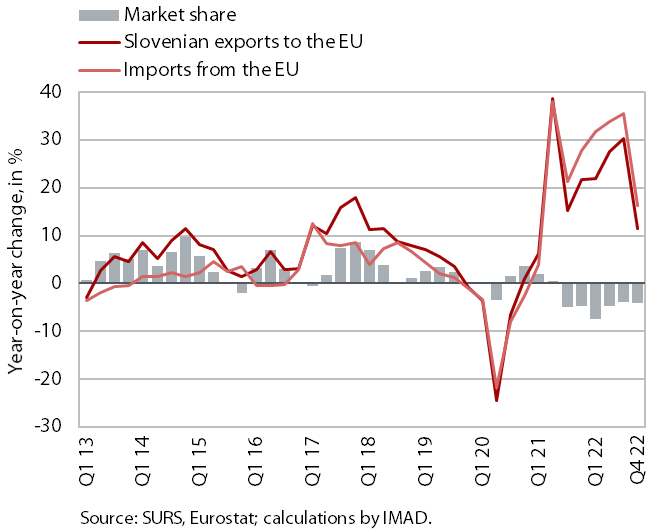
Slovenia’s export market share in the EU market continued to decline in the last quarter of 2022 (by 4.2% year-on-year). It has been declining since the second half of 2021 and was 5% lower in 2022 as a whole, according to initial estimates. Although the decline was largely due to lower foreign demand for products that account for a relatively large share of Slovenian exports (a structural effect), the export performance of individual products also deteriorated in 2022. Market shares have declined in the last quarter and in 2022 as a whole for most main manufacturing product groups, most markedly for road vehicles and electrical machinery, apparatus and appliances. Among energy-intensive products, market shares declined in 2022 for chemical and non-metallic mineral products, and in the last quarter also for non-ferrous metals and paper. Among Slovenia’s main trading partners, France and Germany recorded the strongest drops compared to both the previous year and the pre-epidemic level.
Trade in services – nominal, January 2023
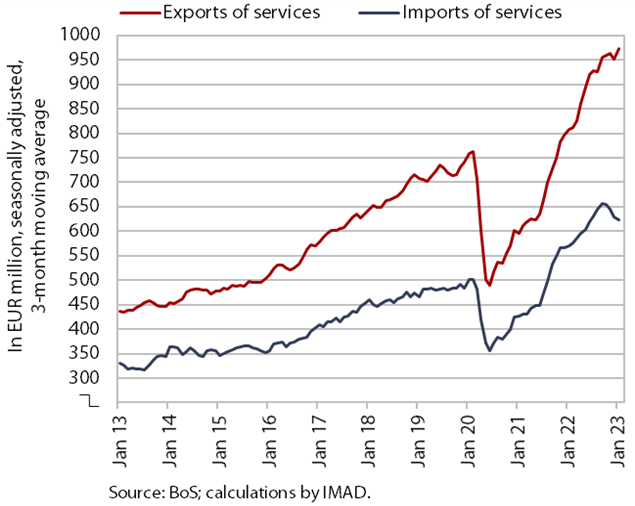
At the end of January, exports of services continued to increase, while the decline in imports came to a halt (seasonally adjusted). As in previous months, export growth was mainly driven by the exports of ICT and other business services, while the value of exports of transportation and tourism-related services remained at the same level as at the end of last year. Among the main import groups, imports of tourism-related services and other business services increased, while imports of transportation services decreased. This was particularly related to weak activity in manufacturing in Slovenia and its main trading partners. Year-on-year growth in trade in services remained strong at the beginning of the year, mainly due to a significant recovery in trade in tourism-related services. Trade in tourism-related services has been above pre-epidemic levels since June 2022, although its share in total services trade is still noticeably lower than before the epidemic.
Production volume in manufacturing, February 2023
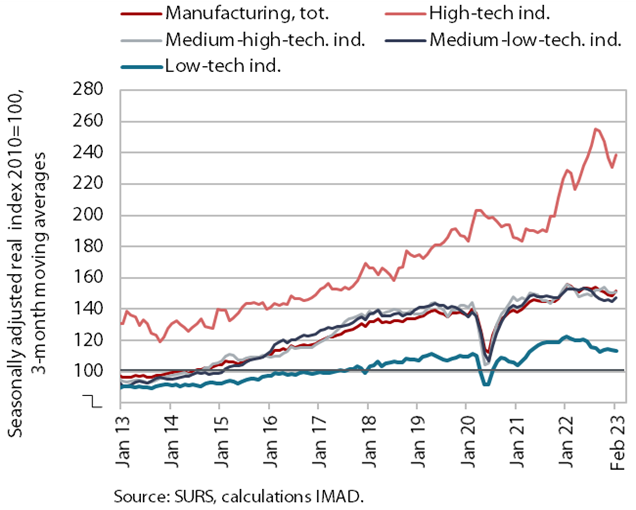
Manufacturing output in the first two months was higher than in the last quarter of last year and similar to the same period last year. Output was higher year-on-year in both high-technology industries (the pharmaceutical industry and manufacture of ICT equipment), which are less affected by the slowdown in external demand growth and the energy crisis. Output was lower on average in all other industry groups in terms of technological intensity. In particular, it was lower in more energy-intensive industries and in the manufacture of motor vehicles. Output was lower than a year ago also in certain low-technology industries (the wood-processing and furniture industries, other manufacturing, manufacture of wearing apparel) and – after high growth in 2022 – the manufacture of electrical equipment.
Activity in construction, February 2023
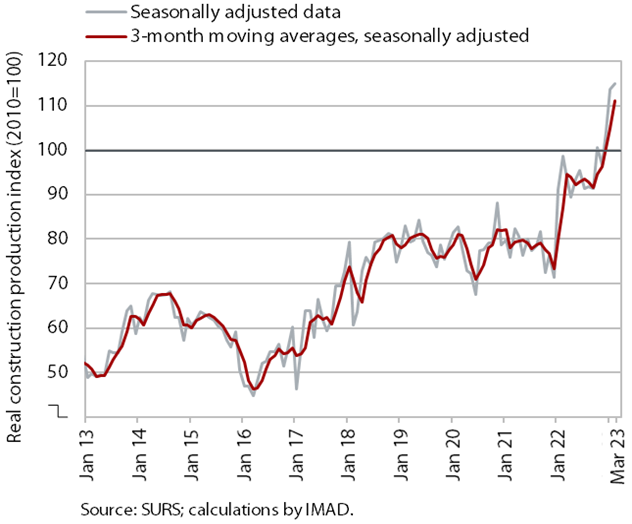
According to data on the value of construction work put in place, construction activity further increased in February. After a sharp upturn at the beginning of 2022, the value of construction work remained roughly unchanged throughout the year before rising sharply towards the end of last year and the beginning of this. In February, it was 18% higher year-on-year. Compared to previous years, construction of buildings, especially of residential buildings, stood out in terms of the level of activity. The implicit deflator of the value of construction work put in place used to measure prices in the construction sector was 12% in February, which was slightly below the 2022 average.
However, some other data suggest significantly lower growth in construction activity. Data on the value of industrial production in two activities traditionally strongly linked to construction do not point to such high growth. Production in other mining and quarrying was 2% lower in February than in the same month of 2022, while it was 7% lower in the manufacture of other non-metallic mineral products.
Turnover in trade, January–February 2023
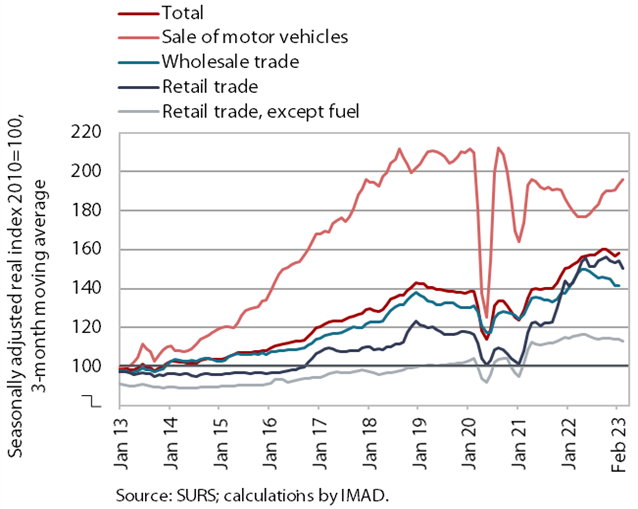
After a temporary increase in January, real turnover fell in most trade sectors in February. After a sharp decline in the last quarter of last year, turnover in wholesale trade rose in January, to a level similar to that in January last year, and it also increased in the retail sale of food, beverages and tobacco, which remained significantly lower year-on-year (by 5.1% in real terms). In January, growth continued in the sale of motor vehicles, where turnover increased significantly year-on-year (14.5% in real terms) due to the low base. After stagnating in the second half of last year, turnover in retail sale of non-food products decreased in January. Preliminary SURS data for February point to lower turnover in all sectors for which data are available.
Turnover in market services, January 2023
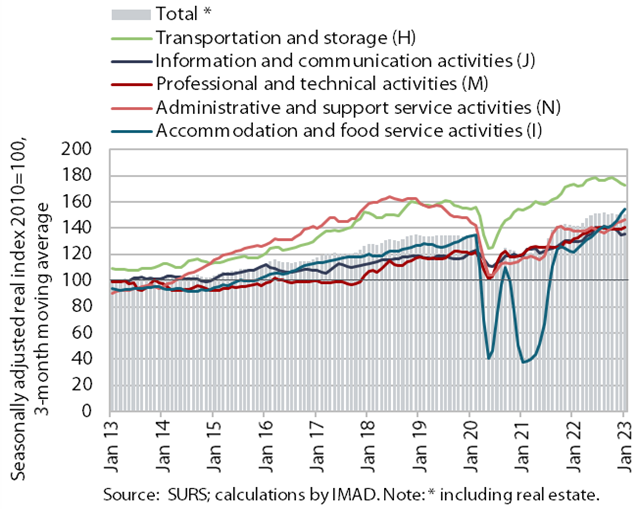
After a decline, real turnover increased significantly in most market services in January. Total turnover in market services declined in the final months of 2022, but it rose in current terms at the start of this year (by 1.8%). High growth continued in the accommodation and food service activities and in professional and technical activities. After a two-month decline, turnover in information and communication activities also recovered, this time driven by significant growth in the sale of computer services in both the domestic and foreign markets. Turnover in transportation and storage declined again, especially in land transport. Turnover in administrative and support service activities remained high, at the level of the end of 2022. In January, total turnover was 7% higher year-on-year in real terms. It was higher year-on-year in all market services and fell short of pre-epidemic levels (compared to January 2019) only in administrative and support service activities (the most in employment agencies, by 28%).
Selected indicators of household consumption, January–February 2023
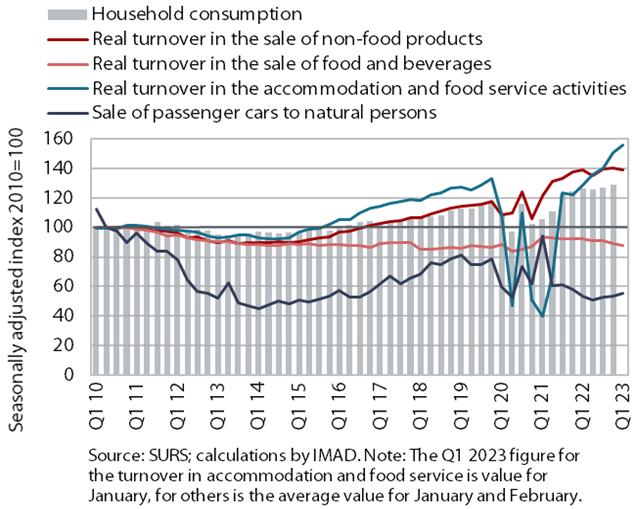
At the beginning of the year, household expenditure on food, non-food products and overnight stays in Slovenia decreased year-on-year, while it increased on cars and tourist services abroad. The sale of food, beverages and tobacco, which has been declining since last spring, and of non-food products was lower on average in real terms in January and February than in the last quarter of last year and also compared to the same period last year. The number of overnight stays by domestic tourists was also lower than a year ago, while expenditure on tourist services abroad increased year-on-year. The sale of passenger cars increased as supply chains eased but was still far behind pre-epidemic levels.
Economic sentiment, March 2023
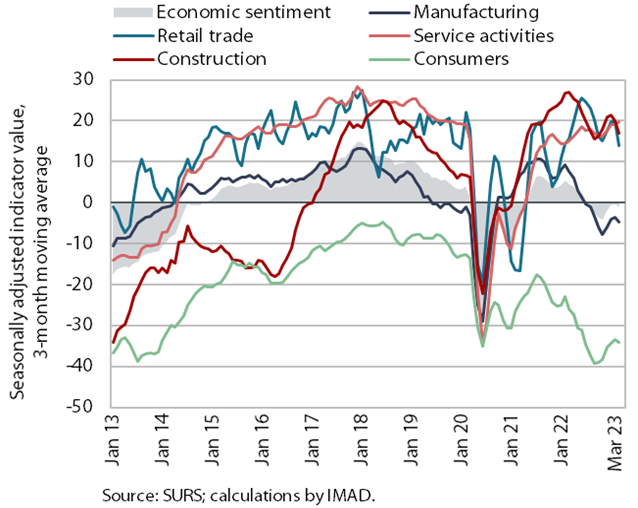
In March, the value of the economic sentiment indicator remained similar to that in February (-0.3 p.p.), while it fell by 2.7 p.p. year-on-year. Compared to the previous month, confidence fell in retail trade, construction and manufacturing, while it rose slightly in services and among consumers. According to the original data, the same confidence indicators deteriorated year-on-year and month-on-month, while confidence improved in services and among consumers. The rise in consumer confidence was driven by more optimistic expectations about the country’s economic situation and the financial situation of households, while service providers assessed their business situation as improved and expected higher demand. The economic climate improved in the first quarter compared to the last quarter of last year, but it deteriorated compared to the same quarter of 2022.
Road and rail transport, Q4 2022
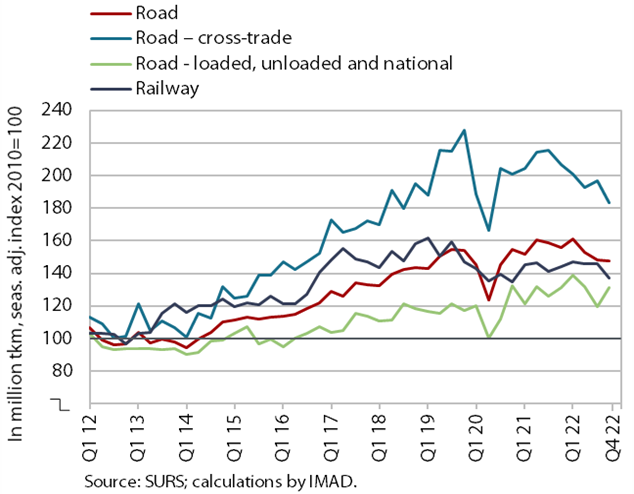
In the last quarter of last year, the volume of road freight transport remained similar to the previous quarter, while the volume of rail freight transport decreased significantly. The volume of road transport performed by Slovenian vehicles decreased slightly quarter-on-quarter due to lower cross-trade and was 4% below the level of the same quarter in 2019 (cross-trade was 20% lower, while other road traffic performed at least partially on Slovenian territory was 12% higher). With the decline in the volume of cross-trade performed by Slovenian vehicles, its share in total traffic also fell sharply (to 43%) and was again significantly lower than in the pre-epidemic period (when it was 51%). Rail freight transport, already declining before the epidemic, was 8% lower than in the same quarter of 2019.
Residential real estate, Q4 2022
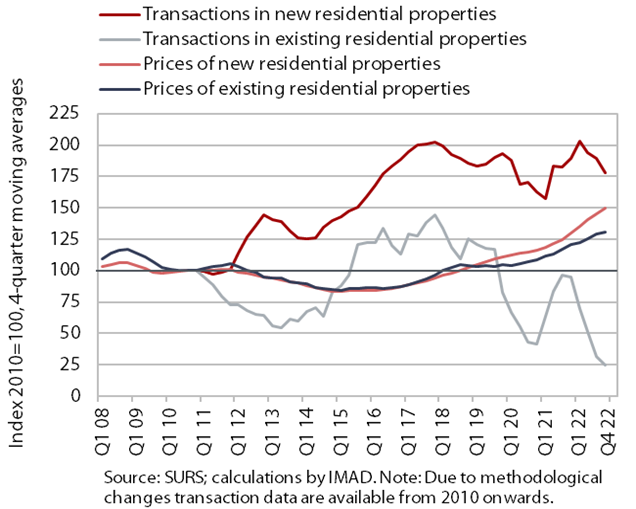
The growth of dwelling prices moderated in Q4 2022 amid a further decline in turnover but remained high year-on-year. Prices were 1% higher than in Q3 2022 and 11.3% higher than in Q4 2021. The still high year-on-year growth was mainly due to higher prices of existing dwellings (by 12%), where the number of transactions was almost a quarter lower year-on-year. Prices of newly built dwellings were also higher (by 5.1%), but these dwellings accounted for only 2% of all transactions. After an increase of 11.5% in 2021, prices rose by 14.7% year-on-year in 2022 as a whole. They were 34.3% higher in nominal terms than in 2008, with prices of existing dwellings rising by 41.1% (by 38.1% in Ljubljana and by 59.9% elsewhere) and prices of newly built dwellings by 11.8%.
Households facing financial distress, March 2023
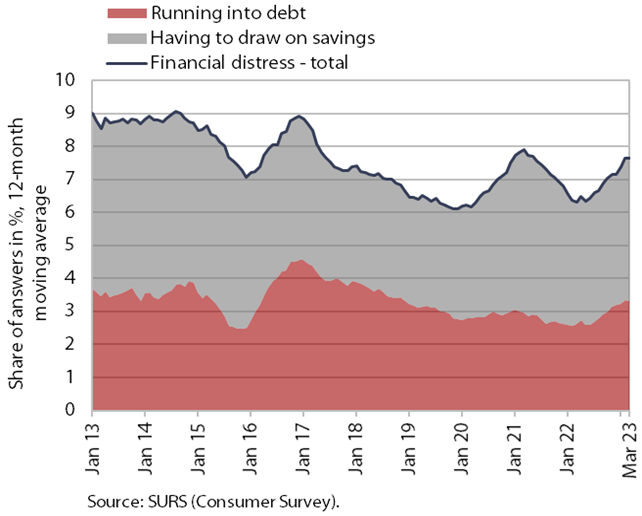
The financial situation of households in the first quarter remained similar on average to the last quarter of last year, but it deteriorated compared to the same quarter of 2022. Compared to the previous quarter, the share of households from the lowest-income quartile facing financial distress decreased (by 1.9 p.p.). This was, according to our estimate, due to the increase in the minimum wage in January and measures taken by the government to mitigate the impact of rising prices on the most vulnerable population groups. The financial situation of households from the second quartile deteriorated (by 2 p.p.). Compared to the same period last year, the share of households facing financial distress was 2 p.p. higher on average in the first quarter. Households facing financial distress continued to cover their financial needs to a greater extent by drawing on savings.
Number of persons in employment, January 2023
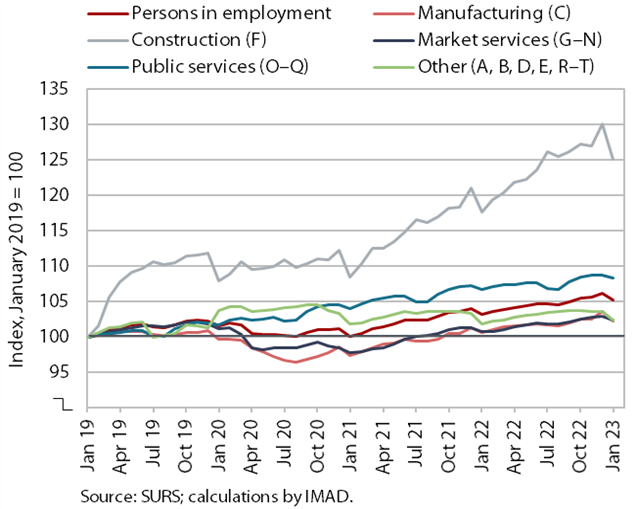
In January, year-on-year growth in the number of persons in employment was similar to the previous months (1.9%). The strongest growth was seen in construction, which is facing a major labour shortage and saw the largest increase in the number of persons in employment compared to the same period in 2019. Employment of foreign workers has been the largest contributor to the overall growth in the number of persons in employment for quite some time – its contribution was 78% year-on-year in January, which is slightly more than in the previous months. Foreigners accounted for 14% of total employment, up 1.3 p.p. from the previous year. The sectors with the highest share of foreigners were construction (47%), transportation and storage (32%), and administrative and support service activities (26%).
Number of registered unemployed, March 2023
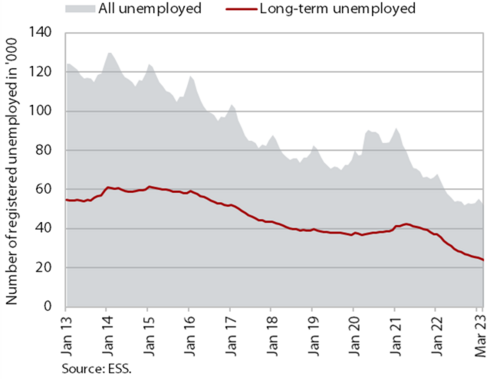
According to the seasonally adjusted data, the monthly decline in the number of registered unemployed was similar in March (by 1.3%) as in the previous two months. According to original data, 50,327 people were unemployed at the end of March, 5.8% less than at the end of February. Unemployment was down 16.9% year-on-year. Against the backdrop of a severe labour shortage, the number of long-term unemployed fell by a third.
Number of FSA beneficiaries and UB recipients, February 2023
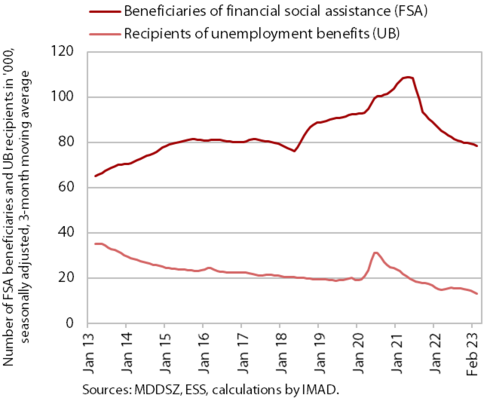
The year-on-year decline in the number of financial social assistance (FSA) beneficiaries and unemployment benefit (UB) recipients moderated in February. The number of FSA beneficiaries has been declining since the middle of 2021, mainly due to an improvement in the labour market situation, and reached its lowest level in October 2022. Since then the number of FSA beneficiaries has increased slightly, mainly due to the fact that from October 2022 to March 2023, property was not taken into account when determining eligibility for the FSA for new applicants. In February, 79,082 people were entitled to FSA, which is around 2,700 more than in October 2022 and 8.9% less than in February 2022. The number of UB recipients was also lower year-on-year in February, by 10.7% (15,593 people).
Average nominal gross wage per employee, January 2023
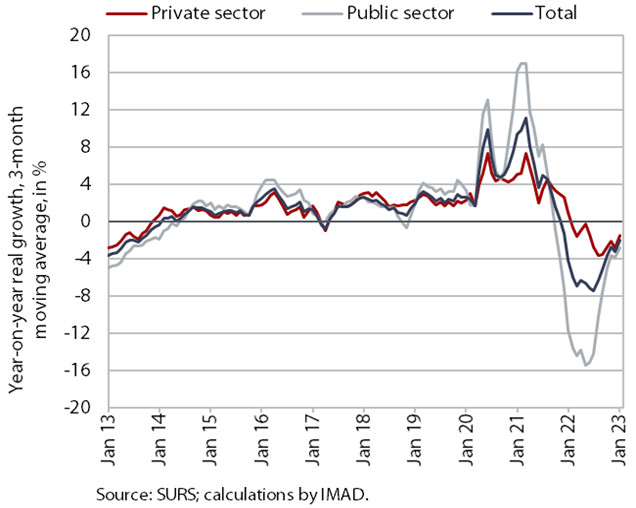
Despite high inflation, the average gross wage increased by 1.3% year-on-year in real terms in January. This was mainly due to the sharp increase in the minimum wage at the beginning of the year and the relatively low base from January 2022. In the private sector, the average gross wage was up 2.2% year-on-year in real terms. Growth was strongest in accommodation and food service activities, a sector which is facing a major labour shortage. In the public sector, gross wages fell by 0.1% year-on-year in real terms, which is a much smaller decline than in previous months. Compared to January last year, the average gross wage increased by 11.5% in nominal terms – by 9.9% in the public sector and by 12.4% in the private sector.
Consumer prices, March 2023
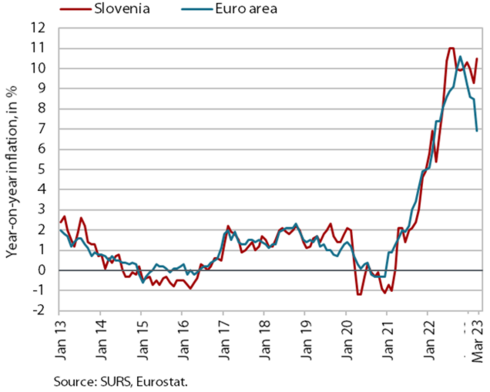
In March, consumer prices remained unchanged from the previous month, while year-on-year growth increased as expected and amounted to 10.5%. Much of the year-on-year increase was due to the lower base from last year, when the government significantly reduced electricity prices by abolishing certain levies and charges. Consequently, prices were almost 50% higher year-on-year in March this year. Prices of food and non-alcoholic beverages, which rose by 19% year-on-year in March, continue to contribute significantly to inflation. Growth of semi-durable goods prices rose to around 6%, with a slightly more pronounced seasonal increase in the prices of clothing and footwear. Amid a monthly decline in furniture prices, year-on-year price growth for durable goods fell sharply to 5.9%, the lowest level since November 2021. Price growth in services also slowed slightly year-on-year (to 6.8%), which we assess to be mainly due to a somewhat more pronounced seasonal drop in prices of package holidays.
Slovenian industrial producer prices, February 2023
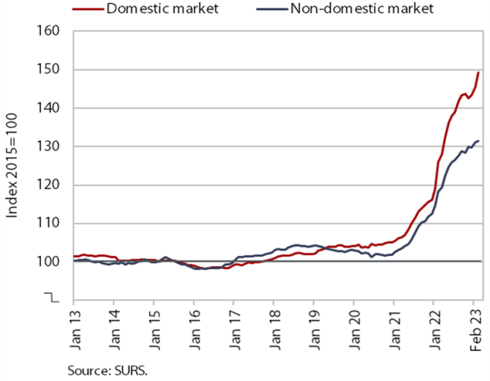
The year-on-year growth of Slovenian industrial producer prices slowed further in February, falling to 14.9%, the lowest level since January 2022. The slowdown was entirely due to the high base from last year, as prices increased significantly (by 1.5%) compared to the previous month. They rose in all industrial groups, with only prices of durable consumer goods declining (by 2.2%). Price growth slowed year-on-year in both domestic (18.6%) and foreign markets (11.2%). Growth of intermediate goods prices slowed further (13.1%), while growth of capital goods (9.1%) and consumer goods (14.2%) prices remained broadly unchanged. Domestic energy prices, which rose by almost 15% month-on-month (while they remained unchanged in foreign markets due to stable conditions), were still significantly higher year-on-year (49.7%).
Loans to domestic non-banking sectors, February 2023
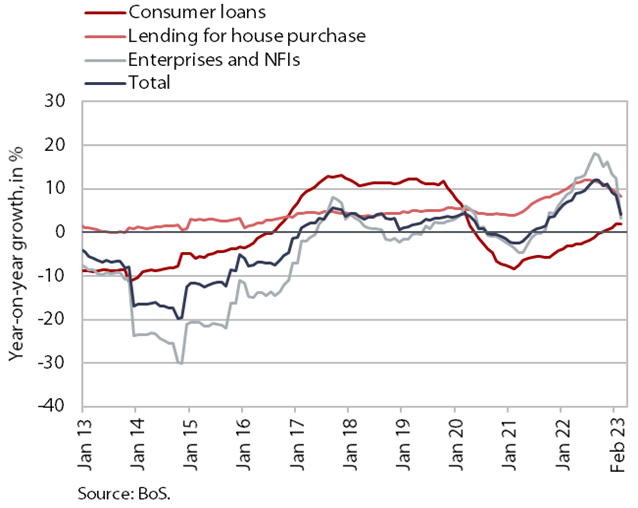
After a gradual slowdown in previous months, the year-on-year growth in the volume of bank loans to domestic non-banking sectors slowed significantly in February. At 4%, growth was the lowest since November 2021, mainly due to a 3.5% monthly decline in the volume of loans to domestic non-banking sectors. This was mainly due to net repayment of corporate and NFI debts (more than EUR 900 million), but also to a slight decrease in loans to households (by EUR 19.4 million). The slowdown in lending activity by the banking system is, in our assessment, due to the cooling of economic activity and the tightening of borrowing conditions as a result of tightened ECB monetary policy. According to data on new lending, lending to non-financial corporations and households declined by more than a quarter in the first two months of the year compared to the same period last year. Year-on-year growth in domestic non-banking sector deposits (6.2%) continues to gradually weaken. Deposit rates are still rising much more slowly than lending rates, so most of the growth comes from an increase in overnight deposits, which account for almost 85% of total domestic non-banking sector deposits and more than 60% of the banking system’s total assets. The quality of banks’ assets remains solid and the share of non-performing loans is still slightly above 1%.
Bond, Q1 2023
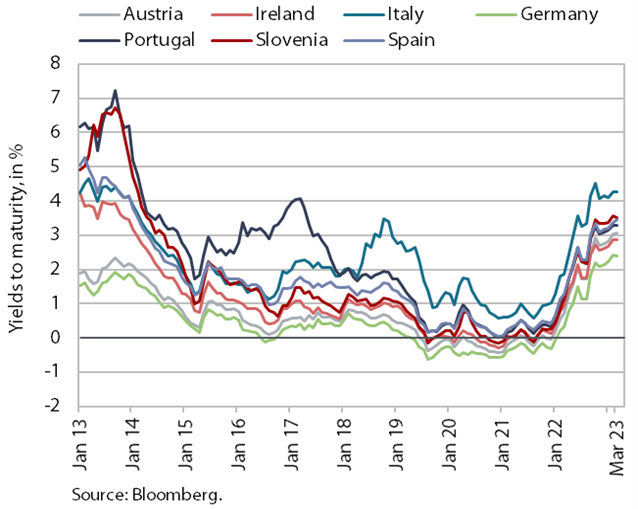
After rising sharply in 2022, yields to maturity of euro area government bonds continued to rise slightly in the first quarter of this year. The yield to maturity of the Slovenian government bond was thus 3.48% in the first quarter of 2023, which is the highest since 2014. The spread to the German bond fell by about 10 bps (to 114 bps) compared to the last quarter of 2022.
Current account of the balance of payments, February 2023
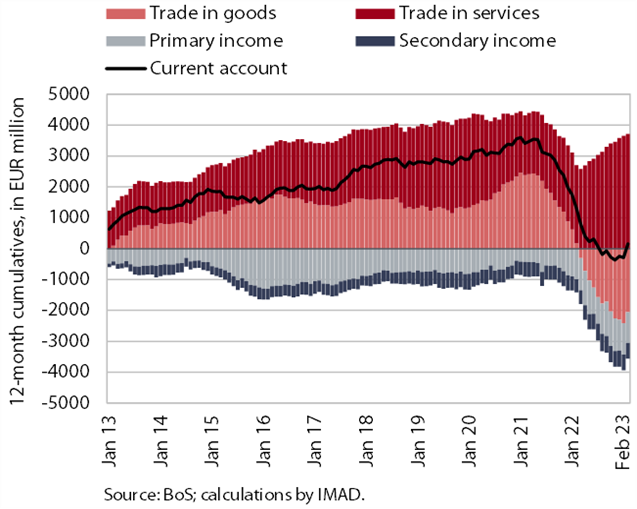
The 12-month current account surplus (until February) was lower year-on-year, amounting to EUR 154.1 million (0.2% of estimated GDP). The lower surplus was largely attributable to the goods trade balance, which turned from a surplus to a deficit in March last year. The primary income deficit was similar to the previous year, while the secondary income deficit was higher year-on-year due to lower receipts from the EU budget and higher VAT- and GNI-based contributions to the EU budget. The surplus in trade in services continued to increase, especially in trade in travel and transportation services.
Balance of the consolidated general government budgetary accounts, January-February 2023
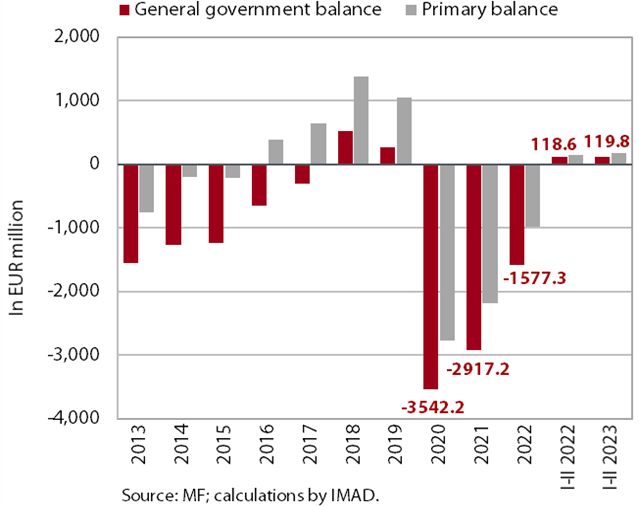
In the first two months of this year, the consolidated general government budgetary accounts showed a surplus of EUR 119.8 million, similar to the same period last year. In the first two months of the year, revenue fell year-on-year (by 0.5%). Receipts from the EU budget were lower, after a sharp increase last year related to the disbursement of part of the advance payment from the Recovery and Resilience Facility and some other non-tax revenue. At the same time, the growth in tax revenues, which at this time last year was still rising sharply due to the post-pandemic recovery, has weakened considerably, the slowdown being partly due to a decrease in tax burdens (income tax, VAT and excise duties on energy products, tax on air pollution from CO2 emissions). Revenue growth was mainly driven by the growth in social contributions in the context of rising employment and accelerated wage growth. Expenditure was also slightly lower than in the same period last year (by 0.5%). This was mainly due to lower expenditure on reserves and payments to the EU budget, but also to lower transfers (subsidies to individuals and households) related to the lifting of measures to mitigate the consequences of COVID-19. On the expenditure side, wages and other labour costs increased. The main factors behind the increase were the agreement to increase public sector wages, interest rates and investment.
EU budget receipts, February 2023
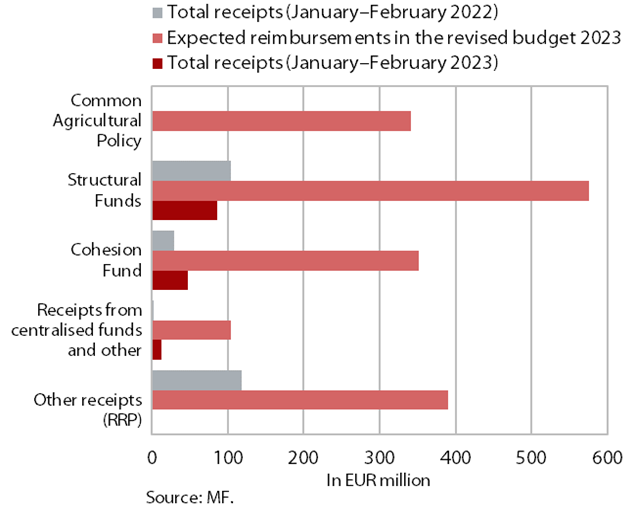
Slovenia’s net budgetary position against the EU budget was positive in the first two months of this year (at EUR 29.9 million). In this period, Slovenia received EUR 146.1 million from the EU budget (8.3% of receipts envisaged in the state budget for 2023) and paid EUR 116.2 million into it (17.8% of planned payments). The bulk of receipts were resources from structural funds (59.2% of all reimbursements to the state budget) and resources from the Cohesion Fund (32.1%). The highest payments into the EU budget came from GNI-based payments (50.3% of all payments).
According to the Cohesion Policy Office, by the end of February funding decisions taken accounted for 113% of the allocated funds under the 2014–2020 MFF (React-EU – 87.4%) and disbursements for 74% of the allocated funds (React-EU – 33.8%).
